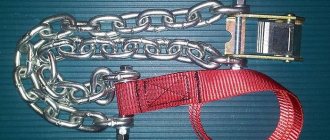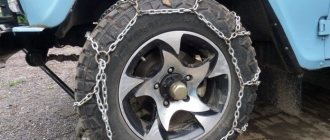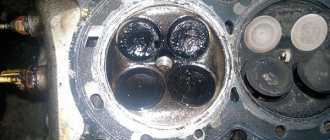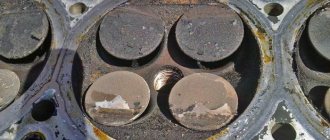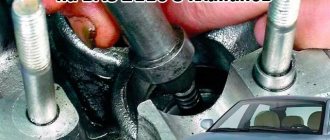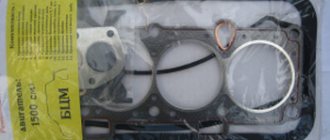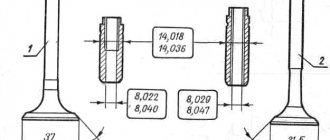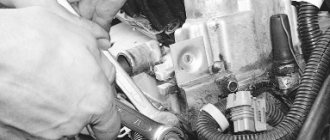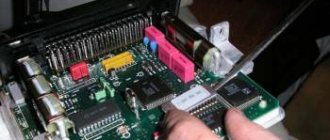When repairing a car engine, the majority of parts are dismantled using standard mechanic tools. In some cases, you may need a special device - valve depressurizer . Its task is to help the driver remove the valve cotter.
The valve desiccant is indispensable when repairing the cylinder head.
Depressuring valves on an Audi A6 - video
First of all, you need to figure out what a cracker is, where it is located on the valves and why it must be removed only with the help of special tools. The task of both the intake and exhaust valves is to close the window very tightly and open it only at the necessary moment.
In order for the valve to be firmly held in the seat, two return springs are put on its rod, pressing on the plate, which in turn is connected to the rod by means of crackers. They are a small cylinder divided into two halves. Inside them, the surface has a spike that fits into the valve groove. Their outer diameter in the assembly is larger than the hole in the plate, which has a special seat.
Thus, the crackers are always securely held, and the force of the springs does not allow them to be removed and the valve released. Although today you can find any engine repair tool on sale, if you have metal processing skills, you can make a desiccant device with your own hands. Those drivers who are used to doing everything with their own hands will make the device quickly and easily.
The design of the device is very simple. To make it, you need to prepare three elements:
- Lever arm;
- holding bracket;
- bracket for pressing on the plate.
To make a lever, a piece of metal tube with a diameter of 1.5 to 3 cm and a length of up to 50 cm is suitable. Both brackets are made according to the same design, but with the only difference that the first must have a hole for attaching it to the head stud, and the second must have a thrust washer , which in internal diameter should be smaller than the valve plate, but larger than its internal hole.
How can you not remove the valve retainer?
Some unfortunate craftsmen suggest using a piece of pipe or a spark plug wrench to remove the crackers. The tube is placed at one end on the valve plate, and the other is struck with a hammer.
Shifting under the impact, the plate releases the crackers, and they fly out of their seats. Considering that they often stick, then we have every chance of bending the valve plate or stem. It is more humane for the “health” of the valve, and for your wallet, to use a special device - a desiccant.
We recommend: Do-it-yourself studding of winter tires
How to remove crackers with your own hands?
The technology for removing cracker cylinders is, in fact, simple for those motorists who are not afraid to repair their cars themselves. You just need to follow the dismantling flow chart and use a special tool.
So, let's start desiccant and to do this we will do the following: The desiccant bracket with the hole is secured with a nut on the head stud or screwed with a bolt. The second bracket is installed on the valve plate and pressure is applied to the free end of the lever. Moving down the valve, the plate exposes the crackers, which are carefully removed. Once the lever is released, the springs and valve can be removed.
If you can remove the crackers using improvised means, then you won’t be able to install them back without our device. That is why, when starting a repair, you need to visit a specialized store or make a valve depressurizer yourself.
Manufacturing of a lever desiccant
Making a universal valve desiccant with your own hands is also not difficult.
- Making a lever. To do this, the rod or pipe must be bent so that it takes the form of lightning. In this case, the bend should be shifted to one side. It turns out that the length of one end is about 15 cm.
- Two through transverse holes are drilled at the short end. The first is at a distance of 1 cm from the edge, the second is at a distance of 12 cm. The diameters correspond to the existing bolts.
- A U-shaped bracket is made from short strips. Holes for the bolt are drilled at the free ends. The partition is made of a washer with a diameter of 25 mm with a hole in the middle. The bracket is screwed to the outer hole in the lever.
- A similar bracket is made from long strips and is also attached to the lever using a free hole.
Finally, we would like to add that in a number of cases, a high-quality and competently manufactured homemade valve desiccant is in no way inferior to its factory counterpart, and sometimes even surpasses it in a number of indicators. And, of course, the cost of the tool will be noticeably lower compared to similar finished products.
Grinding in valves: how to do it yourself. Why and when do you need to grind valves? How to grind valves, what grinding paste to choose. Recommendations.
How to determine a burnt engine valve yourself. The main symptoms of a burnt valve, exact clarification of the causes of engine tripping. Diagnostics, useful tips.
Valves knock on a cold engine or after warming up the engine: possible causes of valve mechanism knocking. Fault diagnosis, useful tips.
Why and when do you need to adjust the valves? Self-adjustment of valve clearances using a feeler gauge and shims. Recommendations.
Purpose of the exhaust valve of the engine timing mechanism. Manufacturing materials and design features, protection of exhaust valves from burnout.
Purpose of the timing valve. Inlet and exhaust valves, design and features of the part. Layout diagrams and valve drive of an internal combustion engine.
Installation Tips
Before installing the shafts, the piston of the first cylinder must be at the “top dead center”. To achieve this, rotate the crankshaft, grabbing it by the screw securing the generator pulley. Here you need a key “17”.
Alternator pulley and two timing shaft pulleys
The camshafts have spikes and the pulleys have grooves. Each pulley is equipped with a mark that should face up. The diagram shown in the photo corresponds to the upper position of piston 1. This is how the shafts are installed during installation.
You can set the crankshaft according to the mark located on the gearbox assembly (photo 1). This is done before installing the belt.
Various auxiliary elements
To set the tension correctly, use basic tips. Or you can do it simpler: when dismantling, note at what angle the tension roller was fixed. The key plate (photo 2) is set at the desired angle and the fixing nut is tightened (force 40 N*m).
How to screw the cylinder head
The threaded part of the screws is lubricated with engine oil. Then, maintaining a force of 20 N*m, the screws are tightened in the required order (see photo).
Recommended sequence (montage)
Second pass - each screw is turned at an angle of 90 degrees. On the third pass, the screws are turned another 90 degrees.
Chemistry
The bearing housing will be connected to the cylinder head cover. The connection itself must be airtight. A sealant is applied to the edge of the body around the perimeter: KLT-75M, Loctite-574, etc. During installation, the cylinder head gasket is not lubricated in principle - graphite or grease will only cause harm. Someone smears valve stems with graphite lubricant, which is also not correct. You need to use motor oil.
Before installation, the new valve is cleaned of factory grease. It is necessary!
Making desiccant
Valve depressurizer
Universal depressurizer diagram
You can assemble a universal valve desiccant with your own hands using simple drawings. It is based on a lever with two brackets attached to it. These brackets are attached using screws and nuts to form a hinge joint. To assemble it you need to prepare:
- Bulgarian;
- Welding machine;
- Durable metal bar for lever;
- Two short strips for making brackets (one is approximately half as long as the other);
- A pipe with a diameter slightly larger than the plate covering the springs and approximately 3-5 cm long.
Weld a washer with a diameter of approximately 8 mm to the shortest strip. It will be used to attach the device to the unit. Its other end is attached to the edge of the lever using a hinge method. A prepared piece of pipe is welded to the middle bar, and also attached to the lever, only closer to its center. To put the structure into action, you need to attach the short bracket to the edge of the head, and install the middle part with the pipe on the plate. Pressing the handle of the structure allows you to press the spring down, freeing access to the crackers.
Causes of illness and required skills
If the oil in the chambers begins to burn, resulting in bluish smoke appearing from the exhaust pipe of your car, then the prerequisite for this may be:
- weakening of oil scraper rings;
- similar weakening of compression (pressing) rings;
Read
If you find something listed above, there is no need to panic or prepare for serious repairs at a service center. If you know at a theoretical level how to change valve stem seals, then even a beginner can cope with a similar task, and if you have at least a little experience in engine repair, it won’t be difficult to quickly solve this problem. The only thing you will need is to stock up on the necessary tools and consumables.
Materials and tools
- Locksmith's hammer.
- A piece of soft (preferably tin) reinforcement (rod) 7-8 mm in diameter.
- Regular pliers.
- Medium sized tweezers.
- Valve desiccant.
- Special frame for pressing new valves.
- Set of ratchet heads.
- A long flat screwdriver (minus).
- Candle key.
- Soap, water, rags to clean your hands.
- A cheerful company of friends and women.
Replacing valve stem seals on a VAZ-08
Rozsukharyuvach valves: In this video I will show you how you can do it yourself without shame
Read
Replacing oil pick-up valves VAZ 2108, 2109, 21099
Replacement method
valve seals (
caps
) at home.
As you can estimate from the list, nothing extraordinary is required for this work. Moreover, if you take everything calmly, such an experience will be useful in the future and will take place in a comfortable environment, you just need to do everything exactly. By the way, to carry out similar actions on other VAZ
, for example, on the classic 2106, 2107, you will need everything the same as for the front-wheel drive 2109, 08 or the latest generations of the Tolyatti plant.
Device
How to make a beard yourself on a VAZ 2107
How to make a valve desiccant with your own hands? Before answering this question, it is necessary to understand the features of fastening crackers, and in general why they are needed. Using these simple parts, the return spring is attached to the valve. To do this, there is a small recess on the valve, usually it runs in a circle. The cracker itself is a hollow cylinder, divided in half. It is placed on the valve stem and secures the spring. The spring plate has a special well that presses the cracker against the valve. This results in a simple and reliable connection.
To dismantle the spring, you need to move the plate down, which allows the cracker to come out of the well, and carefully remove it. For this, special devices are used. They press the spring. There are 2 types of such tools:
Lever
, here the spring is pressed using a lever. A disadvantage of the design is the need to work in pairs. One squeezes the spring, the other removes the crackers with tweezers;
Screw
. Instead of a lever, there is a screw mechanism, so you can work alone. The disadvantage is the need to select a tool for a specific car model.
The second type is more difficult to make, but it is much more convenient. True, the lever can be used on almost any engine model.
Selection of valve stem seals
2109 cars, oil seals are selected whose operating temperature is on average 1,800 degrees. Whereas the material from which they are made can withstand no more than 1,500 degrees. Because of this difference, the service life of consumables is sharply reduced, but this was the case in the early and mid-90s.
Nowadays there are improved products of foreign and domestic production on sale, and at the VAZ plant they install valve stem seals made on the basis of fluorine rubber. This material has proven itself to be positive. Traditionally, foreign brands are characterized by higher quality. Domestic analogues are still inferior to them, except that their price is lower.
The result of worn valve stem seals
When the first signs of wear of parts appear, it is necessary to immediately diagnose the causes of malfunction of the gas distribution mechanism. Including checking the condition of the valve seals. Experienced car enthusiasts who know the structure of the engine are aware of how to check it themselves. Beginners are advised to address this issue to qualified car repair service specialists. Operating a power plant with all signs of wear on the valve stem seals is highly not recommended for a long period of time.
READ Installing a Turbine on a VAZ 2107 Injector
The consequences of operating an engine with such malfunctions are not the most pleasant:
- engine power is significantly reduced;
- unstable operation at idle (stalls);
- “floating” engine speed;
- reduction of compression in cylinders;
- coking (carbon deposits on pistons, spark plugs and cylinder walls).
The appearance of characteristic soot is a serious symptom. Further operation without identifying and eliminating the causes of its occurrence is fraught with engine failure and major (and therefore expensive) repairs.
Lever desiccant
How to make angel eyes for a vase yourself?
To do this you will need 2 metal strips and a steel pipe of a suitable size. A grinder and a welding machine will also come in handy. The planks need to be cut to size. One will be about 2 times shorter. A piece of about 3 centimeters is cut from the pipe, and a short strip is welded to it. The resulting structure is movably connected to a long bar, to which a handle is attached.
This system works as follows: the pipe is placed on the valve plate. The end of the long bar is hooked onto the edge of the head, and the handle is pressed, the spring goes down, which allows you to remove the crackers with tweezers.
Features of dismantling
Dismantling includes such actions as:
- Place a soft stop under the valve.
- Pressing on the plate.
- Removing the crackers with tweezers (a screwdriver with a magnet will also work).
- Moving the plate up. It is important to do everything carefully so that the spring does not bounce off.
Sometimes when pressing on a plate you need to use a striking force, that is, a hammer. There are also special tools. For example, a puller works like a vice.
How to remove crackers incorrectly?
Many people use pieces of pipe or a spark plug wrench to dismantle the crackers: one end of the pipe is placed on the valve plate, and the other is hit hard with a hammer. As a result of the impacts, the crackers are released from the plate, and they jump out of their seats.
However, sometimes sticking may occur during this process, which can result in a bent valve plate or valve stem. Therefore, if you don’t want to “run into” extra financial costs, don’t tempt fate - use a valve desiccant.
Sources
- https://xn--29-6kcd5bg.xn--p1ai/populyarnye-stati/kak-rassuharit-klapana-bez-rassuharivatelya.html
- https://prometey96.ru/lada-remont/rassuharivatel-klapanov-vaz-2112-16.html
- https://PechaleAvto.ru/drugoe/rassuharivatel-vaz-2112-16-klapanov.html
- https://prometey96.ru/ustrojstvo/kak-legko-zasuharit-klapana.html
- https://7gear.ru/avtomobili/kak-rassuharit-klapana-bez-rassuharivatela.html
- https://avto-lover.ru/drugoe/kak-legko-zasuharit-klapana-2.html
Do-it-yourself universal valve desiccant
The question of where to get a valve sealer arises before a car enthusiast after he decides to repair the cylinder head or change the valve stem seals with his own hands. It is not possible to make such repairs without this device.
Why is this device needed?
A valve depressurizer is needed to compress the valve springs during disassembly, as well as during subsequent assembly of the gas distribution mechanism.
Types of desiccant agents
There are two types of desiccants:
- For operation only on a dismantled head.
- Universal. Allows you to work both without removing the head and after its dismantling.
A valve depressurizer for repairing a removed head resembles a clamp for compressing thick parts, which, with its stops, presses on one side the plate covering the springs, and on the other side on the valve.
This tool, of course, is much more convenient than a universal desiccant, since after compressing the springs it leaves your hands free and does not interfere with removing the crackers from the socket.
But you can only use it when the head is removed, and you wouldn’t remove the head of the block just to change the valve stem seals. Therefore, car enthusiasts usually make do with a universal one.
Universal desiccant
Such a device consists of a lever and two brackets, hinged to it using screws and nuts or rivets. The bracket located on the edge of the lever serves to secure the device to the head.
It most often ends in a thick steel washer with a hole about 8 mm in diameter. To bring the desiccant into working condition, it is put on the camshaft bed mounting stud and secured with a nut.
The bracket, located in the middle of the lever, ends with a washer with a diameter slightly larger than the plate of the covering spring and serves to press on it.
If you have the desire and the necessary tools, you can easily make this device yourself. Here is a list of tools needed to make it:
- Hacksaw for metal.
- Drill with drills.
- Semi-automatic welding.
It doesn’t matter if you don’t have a semi-automatic machine, since in this design you only need to make four welding seams, each 1 cm long.
To make this device with your own hands, you need to stock up on the following materials and fasteners:
- A piece of steel pipe with a diameter of about 1.5 cm - 40 cm.
- Screws M 6×25–2 pcs. and nuts for them (also 2 pieces).
- Steel strips 1×5 cm, 3 mm thick – 2 pcs.
- Steel strips 1×15 cm, 3 mm thick – 2 pcs.
- 2 steel washers. One is 2.5 cm in diameter, 3 mm thick with a Ø 8 mm hole in the middle, but the other, unless you are a turner, cannot be made with your own hands. The diameter of the second washer should be 0.6 cm larger than the diameter of the spring plate, and its thickness should be 5 mm. On its working side, a recess should be made 2–3 mm deep with a diameter equal to the outer diameter of the plate. And in the middle make a hole slightly smaller than the recess.
In order to begin assembling the device, you need to make brackets from washers and steel strips. To do this, place the thrust washer with the recess down, and place steel strips diametrically opposite to its edges and weld them.
The second knot is made in the same way, the only difference is that the washer is placed arbitrarily. After the welding has cooled, you need to drill a Ø 6.5 mm hole in each strip. They should be located at a distance of 0.3–0.4 cm from the unwelded edges.
After this, use the same drill to drill two holes in the pipe section. One of them is half a centimeter from the edge, the other is in the middle. Now we can assemble our device. Using screws and nuts, attach a bracket with a flat washer to the edge of the lever and another in the middle. After completing the installation, the device is ready for use.
How to use the device
After removing the camshaft, place the outer bracket on the stud that held the bed and screw the nut onto it. Place the shaped washer of the other bracket on the plate covering the valve springs and press the lever with your hand. The outer surface of two crackers folded together is a truncated cone, just like the seat for them in the plate.
Therefore, sometimes the plate, when pressed, is held by crackers on the valve stem. In this case, you need to lightly hit the middle of the lever from above with a hammer. When the springs are compressed and the plate moves down the valve stem, use your free hand to take tweezers and use them to remove the crackers from the socket.
Remove both springs along with the other parts from the rod and move the device to the next stud.
Tags: dry, dry, valve, VAZ, 2110, 2112, without tools, simple, easy, method
Comments 27
As soon as I remember, I’ll shudder - how many gray hairs these crackers have added to me... And it’s so good - fast and comfortable)))
this is called degradation. a return from civilized methods to the hammer. when there is no desiccant there is a way out, but it’s not serious. no offense.
Not serious, judging by the first 15 seconds of an 8 minute video
what's behind these conclusions? I looked at it in its entirety and what does it change? For many of us, the know-name desiccant “from the market” has nothing to do with the bed, and I’ve never seen any problems with crackers flying away.
Never mind, you just admitted that my conclusion is correct... From the context it is clear that you did not watch the video the first time)))
2 Most likely you haven’t read the comments, from which it is clear that I have a good desiccant for 4 kilo rubles, as in the picture, and a “bad” one for 8 kilo rubles. So it’s not a matter of lack of tools, experience, desire, etc. But the only thing is that the method is really good!
3 if your crackers have never fallen out, it means you have little experience. Everyone who deals with this will say that crackers flying out is a problem. Resulting from a gradually increasing force, on an unevenly positioned cracker, when the spring opens. And there is no salvation - you have one hand occupied, with which you press the lever (and it is tired) in the second you have, fucking tweezers! It is also important to press evenly, otherwise one of the crackers will not “go in” both at the beginning of the phase and at the end - for this, the installation of a desiccant is important, both in terms of reach and leverage.
I’ll also note that the cracker with a large ring (type 8 bug, but it doesn’t always fit into foreign cars) pressing on the plate comes very close to the bed of the pushers, and you can accidentally scratch it, but it’s easier to insert the crackers with tweezers or something else. And with a small ring, they make it difficult to access the breadcrumbs, and sometimes they are likely to slip off the valve plate (the shape of the plates does not always fit well with the desiccant press)
So this is what I’m getting at... The method really saves time and nerves, I regret that I didn’t use it earlier, because if the cracker shoots out, it will be in a rag, and the sizes of the heads in the standard set are more than enough. If you wish, you can dry with one hand, and if you try, (place emphasis on the shoulder, like a crutch) without any hands at all. And this is about the least favorite operation for mechanics...
The man in the frame, Denis, is drying out the last 4 valves - for the first time in his life, three times faster than you can do with the best desiccant. DOES THIS TELL YOU WHAT? Well, stand your ground, please, since it’s hard to admit that you ate shit. I don't care anymore, continue. THIS IS A BAD METHOD, YOU SHOULD NOT EVEN PAY ATTENTION
You yourself ate shit)) I’m not proving anything to you, I watched the video twice without sound. I studied to be an auto mechanic... from 20 to 22 years old I worked as an assistant to a diesel engine mechanic. Well, we won’t mention our garage and the guys in the garages. You’re right In your video, I saw crackers for the first time. In fact, you can plan the head with sandpaper and a board, but the hat method is only suitable in the absence of a tool; on serious springs you will either have to suck it out or you will have to hammer it hard.
Never mind, you just admitted that my conclusion is correct... From the context it is clear that you did not watch the video the first time)))
2 Most likely you haven’t read the comments, from which it is clear that I have a good desiccant for 4 kilo rubles, as in the picture, and a “bad” one for 8 kilo rubles. So it’s not a matter of lack of tools, experience, desire, etc. But the only thing is that the method is really good!
3 if your crackers have never fallen out, it means you have little experience. Everyone who deals with this will say that crackers flying out is a problem. Resulting from a gradually increasing force, on an unevenly positioned cracker, when the spring opens. And there is no salvation - you have one hand occupied, with which you press the lever (and it is tired) in the second you have, fucking tweezers! It is also important to press evenly, otherwise one of the crackers will not “go in” both at the beginning of the phase and at the end - for this, the installation of a desiccant is important, both in terms of reach and leverage.
Design and principle of operation of the desiccant
The valve depressurizer is needed in order to smoothly compress the valve spring, hold it in a compressed position, thereby moving the spring mounting plate down and releasing the cracks. After removing the crackers, use a desiccant to gently release the spring so as not to damage anything. It's simple!
Valve seals have many designs, to the point that each series of Mercedes engines requires its own seal. But any desiccant cannot do without the following mandatory elements:
- An annular stop for pressing on the valve plate - most often in the form of a tube with large cuts in the walls to remove crackers through them;
- Depressurizer frame - with which the valve spring is held in a compressed position;
- Handle or screw - which creates the force to compress the valve spring.
What is a valve spring retainer?
The valve spring retainer is a small part that consists of two identical parts; if you put these parts together, you get a conical cylinder. On the inside of the crackers there are fastenings, with the help of which the cracker is attached to the valve stem. The valve stem must have grooves into which the fasteners for the cracker are inserted.
The valve spring is always compressed. Trying to unclench, she pushes the valve plate up. The valve plate compresses the nut around the valve stem. The cracker, which holds onto the grooves on the valve stem, prevents the plate from moving upward and thereby decompressing the valve spring. This is what secures the valve to the valve seat.
How to dry out the valves in the cylinder head
If you have repaired your car yourself, you have probably heard about such a device as a valve depressurizer. It is needed in order to remove the valve from the guide sleeve, having first freed it from the cracker.
So, if you have never encountered such a procedure, you can see how this happens using a clear example of VAZ “classic” cars. Of course, to carry out such a procedure we will need a special device, which is called a valve desiccant.
The photo above clearly shows what this device looks like in action. Of course, you must first remove the valve cover to get to the valves themselves.
But here it’s worth keeping in mind, it’s important to understand for what purpose you will be desiccating them:
- if it is to replace valves, then all this is done with the cylinder head already removed from the block
- if to replace oil seals (valve seals), then removing the cylinder head is not required
But in the second case, you need to ensure that when you press the valve, it rests against an obstacle inside the cylinder so that it can be desiccated. This can be done quite simply: unscrew the spark plug and insert a tin wire or even a rope into the hole, the main thing is not to damage the cylinder inside.
When there is a good stop, you can use a device to press the valve spring to get something like the following picture:
As you can see, the valve spring should be compressed as much as possible by the action of the puller, and the crackers at this moment remain free on the valve. They can be easily removed either using tweezers, or even more conveniently using a magnetic handle, as shown in the photo below.
After this, you can remove the spring for further actions, since no more additional manipulations are required.
But when all the necessary actions and repairs are completed, you will need to reinstall the crackers in their places. And then you will need to do everything in the reverse order: compress the spring in the same way and install the crackers in their places. Loosen the spring and do the same with the other valves.
If the article was interesting, subscribe to the channel and don’t be lazy to put your finger up to receive notifications about the release of new materials every day!
One of the essential elements of any internal combustion engine is the intake and exhaust valve. Their correct operation allows us to ensure high quality operation of the fuel system, and therefore the entire vehicle as a whole. Valves are installed not only in the engine, but also in many other parts of the machine: injectors, fuel rail, gearbox. They circulate liquid and gas through various car systems, and their breakdown can lead to a number of problems.
Adjusting valves on VAZ 2108, VAZ 2109, VAZ 21099
Welcome! There must be a valve clearance, but it must be minimal, otherwise, if there is no clearance, the valves will not be able to close reliably. In this case, depressurization will occur in the cylinders and the power will noticeably drop, and the exhaust valves will begin to burn out. On the other hand, the gap is increased - the valves will not be able to open completely while the engine is running, thereby the power will again drop, because the engine will not be able to supply the fuel-air mixture, because the valves do not open completely. Moreover, the valves can rattle when there is a large gap, and after adjusting them, when you start the engine, you will immediately feel how it will run quieter and in the future you will understand when it is time to adjust the valves on the car.
Brief:
Manufacturing of screw desiccant
- Making a frame bracket. This is the main part of this type of desiccant. It can be cut from a single sheet of metal, but it will be much more convenient to weld it from several pieces of profile or thick steel strips. The dimensions depend on the specific car model, but the average internal indicators are as follows: length of at least 210 mm, width of at least 150. The result is a frame in the form of a large printed letter C.
- After the bracket is ready, nuts are welded onto the ends of the short sections.
- A piece of pipe is also welded to one of the bolts. Either a large washer or a valve plate is welded to the second one - this will be a support.
- The bolts are screwed into the welded nuts so that when screwed they move towards each other and towards the center of the bracket.
Necessary parts and tools for repair
Troubleshooting the cylinder head begins with the purchase of original parts and various consumables, the list of which is as follows:
- Fuel intake system valve 8 pcs. (art. 21120-1007010).
- Exhaust gas valve 8 pcs. (art. 21120-1007012).
- Set of hydraulic compensators 16 pcs. (art. 21120-1007300).
- Gaskets for valve cover, cylinder head, intake manifold, exhaust manifold (all come as a set art. 21120-1002064-86).
- Bolts securing the cylinder head to the engine crankcase (art. 21120-1003271-018).
- Timing belt (art. 2112-1006040-02RU), timing tension roller (art. KT100507/100513), drive belt for mounted units (art. BP638).
- Engine oil and oil filter.
- Cooling system fluid.
Installation of valves on a VAZ 2112 is carried out using a standard set of tools, as well as several specialized types of keys:
- standard set of spanners from 8 to 24 mm;
- socket sockets in a set from 8 to 27 mm;
- end internal hexagons;
- mechanical valve retaining ring remover (depressurizer);
- torque wrench for tightening the cylinder head and camshaft bolts;
- paste for grinding valves (set for rough and fine grinding);
- metalworking cloth gloves to protect hands while working.
The work of replacing 16 valves on a VAZ 2112, the price of which as of this fall is about 50 thousand rubles at AvtoVAZ dealerships (or approximately 35-40 thousand rubles at ordinary car repair shops), is not a very complicated process. You can carry out the work yourself, for which it is enough to purchase the above-described spare parts and the necessary tools.
How to dry valves correctly?
In fact, the technology for dismantling cracker cylinders is a simple task that any non-professional can handle. To do this, you just need to get a technological map and a desiccant.
What you need to make your own desiccant
To make this device, you will first need suitable materials. For the clamp option you need to have:
Currently reading
- Metal profile or sheet metal 10-15 mm thick;
- A couple of large bolts or studs (screws will be made from them, so the length of each is at least 15 cm);
- Two nuts comparable to the bolts.
For the lever option, you must stock up on the following elements in advance:
- A metal pipe or rod with a diameter of about 15 mm and a length of up to 40-50 cm;
- Two steel strips 20-30 mm wide and 5 cm long. Thickness about 3 mm.
- Two strips 20-30 mm wide, up to 3 mm thick, 15 cm long;
- Two 6x25 mm bolts with nuts and washers;
- Two steel washers (you can make your own). The first has a diameter of 25 mm, a thickness of about 3 mm, and an internal hole of 8 mm. The second has a diameter slightly larger than the spring plates. Its thickness is at least 5 mm.
Of course, it will not be possible to make a valve desiccant without available tools. Required:
- Grinder or hacksaw for metal;
- Welding machine (you will have to make several seams of 2-3 cm each);
- Vise;
- Drill and drill bits for metal;
- Spanners.
Making a valve desiccant with your own hands: description, diagrams
Every motorist sooner or later faces the need to repair his car. Some people prefer to entrust this work to a car service, while others like to repair their car themselves. But not every breakdown can be eliminated without the help of special devices. Therefore, if it is necessary to disassemble or assemble the gas distribution mechanism, car enthusiasts are interested in how to make a valve depressurizer with their own hands. The desiccant will help greatly facilitate the repair of the cylinder head, or will be useful when replacing valve stem seals. With its help, you can easily press the spring to remove the crackers. Of course, a device for desiccating valves can be purchased at a car dealership, but it is often much more convenient to make it yourself. In this case, it will fully meet your requirements.
Types of devices for desiccation of valves
There are two types of devices for desiccation of valves, which are fundamentally different from each other:
- The lever desiccant is a universal device. It can be used both with the head removed and without dismantling it (for example, when changing oil scrapers). A significant disadvantage is the need for pair work - while one person presses the spring, the other needs to get the crackers. Making this tool is not as difficult as it might seem at first glance.
- A screw desiccant is more convenient to use, as it allows you to work alone. The disadvantages of such a tool include the need to dismantle the head and select it for a specific model of the unit. And making this type of valve desiccant with your own hands is more difficult.
Making desiccant
Universal desiccant diagram
You can assemble a universal valve desiccant with your own hands using simple drawings. It is based on a lever with two brackets attached to it. These brackets are attached using screws and nuts to form a hinge joint. To assemble it you need to prepare:
- Bulgarian;
- Welding machine;
- Durable metal bar for lever;
- Two short strips for making brackets (one is approximately half as long as the other);
- A pipe with a diameter slightly larger than the plate covering the springs and approximately 3-5 cm long.
Weld a washer with a diameter of approximately 8 mm to the shortest strip. It will be used to attach the device to the unit. Its other end is attached to the edge of the lever using a hinge method. A prepared piece of pipe is welded to the middle bar, and also attached to the lever, only closer to its center. To put the structure into action, you need to attach the short bracket to the edge of the head, and install the middle part with the pipe on the plate. Pressing the handle of the structure allows you to press the spring down, freeing access to the crackers.
Screw model of valve depressurizer
It can be made using available materials. Since the model has a clamp structure, it is more convenient to create a desiccant based on it. To make a homemade screw valve depressurizer, we will prepare the following materials:
- Bulgarian;
- Welding machine;
- 2 extended nuts;
- 2 long bolts;
- A piece of pipe, 3-5 cm long, and slightly larger in diameter than a plate;
- A washer with a diameter suitable for the pipe.
Desiccant on a clamp
We cut out the workpiece from the profile so that we can weld the part in the shape of a bracket. The length of the main workpiece is 250 mm, the side pieces are 150 mm. We weld the power frame. For clamps we use extended nuts and long bolts. The nuts are welded to the steel profile, and bolts are inserted into them towards the center of the structure. A piece of iron pipe, approximately 3-5 cm long, is welded onto one of the bolts. Pre-weld one hole in the pipe with a washer of a suitable diameter. Use it to attach (or weld) the tube to the bolt. For use, the desiccant is installed on the block head as follows: a piece of pipe is installed on the spring plate, and with the help of a second bolt this spring is displaced (compressed). After this, crackers are taken out. It's easier to do this with tweezers.
As you can see, making a device for desiccating valves with your own hands is not at all difficult. You will need simple materials and a little time spent to comfortably carry out repairs on your favorite car.
Types of devices for desiccation of valves
There are two types of devices for desiccation of valves , which are fundamentally different from each other:
- The lever desiccant is a universal device. It can be used both with the head removed and without dismantling it (for example, when changing oil scrapers). A significant disadvantage is the need for pair work - while one person presses the spring, the other needs to get the crackers. Making this tool is not as difficult as it might seem at first glance.
- A screw desiccant is more convenient to use, as it allows you to work alone. The disadvantages of such a tool include the need to dismantle the head and select it for a specific model of the unit. And making this type of valve desiccant with your own hands is more difficult.
Valve desiccant.
When repairing a vehicle, a mechanic uses a large number of tools. And in some situations it becomes necessary to use such a special device as a valve depressurizer. Its main task is already clear from the name - to help a specialist remove the valve cotter.
What is a valve desiccant?
Therefore, first of all, we will understand what a cracker is, where exactly it is located on the valves and why its removal can only be done using a special tool.
So, as you know, the main task of the exhaust and intake valves is to tightly close the engine cylinder window, as well as to open it at the right time.
The implementation of this process is possible thanks to two return springs: they press on the plate, which in turn is connected to the rod using crackers. They, together with the force of the springs, hold the valve firmly in the seat when performing its main function.
These crackers look like a small cylinder divided into two halves. Inside its surface there is a spike that fits into the valve groove. The outer diameter of the crackers is larger than the inner diameter of the plate. Consequently, they are held very securely and strongly - so strongly that they can only be removed with a desiccant.
The latter, by the way, is a fairly simple structure that you can build yourself. To do this, you only need 3 elements: a lever, a bracket for pressing on the plate and a holding bracket.
The first can be made from a metal pipe (its length should not exceed half a meter), with a diameter of one and a half to three centimeters, and the last two can be created according to the same pattern, only one should have a hole for attaching it to the head pin, and the second should have a persistent a washer with an internal diameter smaller than the valve plate, but larger than its internal hole.
How to dry valves correctly?
In fact, the technology for dismantling cracker cylinders is a simple task that any non-professional can handle. To do this, you just need to get a technological map and a desiccant.
So, in order to do desiccation, you will need to perform the following steps. First of all, you need to screw the desiccant bracket with the hole onto the head stud using a nut or screw it with a bolt. And install the second bracket on the valve plate and apply gentle pressure on the end of the lever. Thus, moving down the valve, the plate will release the crackers, which are then carefully removed. Next, after them, you can remove the spring and valve.
Of course, you can remove the crackers with any other handy tool, but you are unlikely to be able to put them back in their place without a special device. Therefore, before starting repairs, you need to prepare, that is, purchase or make your own desiccant.
How to remove crackers incorrectly?
Many people use pieces of pipe or a spark plug wrench to dismantle the crackers: one end of the pipe is placed on the valve plate, and the other is hit hard with a hammer. As a result of the impacts, the crackers are released from the plate, and they jump out of their seats.
However, sometimes sticking may occur during this process, which can result in a bent valve plate or valve stem. Therefore, if you don’t want to “run into” extra financial costs, don’t tempt fate - use a valve desiccant.
Malfunctions of valve stem seals
High quality materials do not guarantee the eternal operation of valve seals; sooner or later, under the influence of negative factors (high temperatures, aggressive chemical composition of oil, etc.), slight wear of a regular nature occurs, which ultimately leads to the fact that these parts can no longer perform their functions fully. The working surface is rubber and over time the structure becomes compacted, as a result of which elasticity is lost and cracks begin to appear. Long-term operation and exposure to an aggressive environment with high temperatures does not have the best effect on the damper spring. Ultimately, all this leads to the fact that the valve stem seals no longer effectively remove oil from the valve stems, and it ends up in the combustion chambers.
When is it recommended to replace valve seals?
how to dry out valves without special tools
The fact that it is necessary to change the seals is indicated by some characteristic features.
Operating principle of valve stem seals
These parts are included in the gas distribution mechanism, as they function in close contact with the valves, which are an important part of the timing belt. Valves are divided into exhaust and inlet. Their upper part is always in the zone of oil mist, which is created by the rotation of the camshaft. Their lower part is in the area of the fuel-air mixture (for the intake valve) or in the area of the exhaust gases (for exhaust valves). For the camshaft to function properly, it urgently needs constant lubrication, but oil getting into the combustion chambers negatively affects the operation of the power plant.
When a valve is raised or lowered, oil is removed from its stem each time. This work is performed by valve stem seals. These small parts prevent the poppets and valve stems from becoming coked.
Carbon deposits appear when the fuel-air mixture ignites. In this case, excess oil burns, which leads to coking. Engine wear increases, the fuel-air mixture becomes leaner, and the engine begins to operate unstably. The good condition of the seals is very important, and they are subject to serious quality requirements.
Signs of trouble
The following factors indicate that these consumables are badly worn:
- oil consumption has increased;
- dark carbon deposits on spark plugs;
- the appearance of bluish exhaust smoke (especially during cold start and warm-up).
The appearance of oil leaks due to worn valve stem seals is quite understandable. After all, engine oil enters the combustion chambers and is not used for its intended purpose for lubrication. As a result of the combustion of oil with fuel, the lubricant level in the crankcase gradually drops, and the car owner has to constantly add fresh oil.
When oil burns, blue-colored products are released. Accordingly, the exhaust gases are also painted the same color. As the engine warms up, the oil burns out completely, so there is no blue smoke from the exhaust pipe on a hot engine.
Oil entering the cylinder chambers during combustion settles not only on the walls, pistons and rings, but also on the electrodes of the spark plugs. Hence the black coating on them.
Screw desiccant
These are easier to operate mechanisms. There are several varieties of such instruments. In a garage, you can easily make a rack-and-pinion version, but the disadvantage of such a device is that it is tailored to one engine model. Clamp options are essentially universal. It's easy to make them:
- Made of sheet metal 12-15 mm thick. cut out the bracket, this will be the power frame of the device;
- The clamping bolt is made from any stud of suitable diameter. If you have a lathe, it is better to make the bolt yourself;
- We make a support. To do this, you will have to turn to a turner; the finished element is welded to the bracket;
- We buy a nut, but if you turned the clamping bolt yourself, then it’s better to make that too. The nut is then welded to the support;
- We weld the bushing. First, it is attached to a short pin, which in turn is attached to a bracket. It is better to select a sleeve with holes along the edges, this will make it easier to remove the crackers.
We are conducting sea trials. To do this, the finished device is installed on the block head. In this case, the bushing is placed on the spring plate. The movement is made using the clamping bolt. The sleeve is pressed against the plate and moves it down. Your task is to remove the crackers with tweezers and finish disassembling the valve. If you plan to continue using this valve, you must remember its location. Usually the oil seals are changed at the same time.
For the rack version you will need the actual metal rack. It is welded to the support legs, which are equipped with devices for installation on the head. The rail has a slot along which the die with the pin moves. At the end of the pin there is a piece of pipe. By tightening the pin, you can clamp the valve spring and remove the crackers.
Conclusion
. For a complete and quick engine repair, you need some tools. Thanks to which, you will significantly speed up your work time. Therefore, many are interested in how to make a valve desiccant with their own hands. After all, without this tool it is quite difficult to repair the cylinder head.
Self-replacement of VAZ-2112 hydraulic compensators
A hydraulic compensator (or hydraulic pusher) is used to adjust thermal clearances in 16-valve engines.
Essentially, it is a “layer” between the camshaft and the valve, which adjusts its own thickness due to the plunger. That is, when the empty side of the distributor “fist” rotates, a space appears, which is compensated by raising the hydraulic pusher cylinder. In this case, the oil enters the compensator cavity itself. The reasons why hydraulic compensators may become faulty usually include wear and tear during operation, clogged oil channels, or plunger wear. In the last two cases, it is recommended to check the oil pump and the lubrication system as a whole for possible malfunctions. The main symptom of failure of the pushers is a typical knocking sound from the engine; an additional check - after removing the cover from the cylinder head - is that there is no resistance when pressed. It is better to replace hydraulic compensators comprehensively, since the reasons for the failure of one of them equally affect all the others. The cost of the kit for the VAZ-2112 is from two to three thousand rubles.
The replacement procedure itself is possible only after removing the cylinder head. After identifying the malfunction, you should remove the camshaft pulleys (if you have not already dismantled the entire block) and remove the oil pressure sensor. Next, the camshaft bearing housing is unscrewed (twenty bolts per piece) and the bracket securing the rod to the rear support is removed. Then the camshaft itself is removed, as well as the spark plug pipes and seals.
After dismantling the plugs, you can remove the defective hydraulic compensators using a magnet. Then new ones are installed, and after cleaning and lubricating the cylinders and bearings, the block is assembled (in reverse order).
Universal desiccant
Such a device consists of a lever and two brackets, hinged to it using screws and nuts or rivets. The bracket located on the edge of the lever serves to secure the device to the head. It most often ends in a thick steel washer with a hole about 8 mm in diameter. To bring the desiccant into working condition, it is put on the camshaft bed mounting stud and secured with a nut. The bracket, located in the middle of the lever, ends with a washer with a diameter slightly larger than the plate of the covering spring and serves to press on it.
If you have the desire and the necessary tools, you can easily make this device yourself. Here is a list of tools needed to make it:
- Hacksaw for metal.
- Drill with drills.
- Semi-automatic welding.
To make this device with your own hands, you need to stock up on the following materials and fasteners:
- A piece of steel pipe with a diameter of about 1.5 cm - 40 cm.
- Screws M 6×25–2 pcs. and nuts for them (also 2 pieces).
- Steel strips 1×5 cm, 3 mm thick – 2 pcs.
- Steel strips 1×15 cm, 3 mm thick – 2 pcs.
- 2 steel washers. One is 2.5 cm in diameter, 3 mm thick with a Ø 8 mm hole in the middle, but the other, unless you are a turner, cannot be made with your own hands. The diameter of the second washer should be 0.6 cm larger than the diameter of the spring plate, and its thickness should be 5 mm. On its working side, a recess should be made 2–3 mm deep with a diameter equal to the outer diameter of the plate. And in the middle make a hole slightly smaller than the recess.
In order to begin assembling the device, you need to make brackets from washers and steel strips. To do this, place the thrust washer with the recess down, and place steel strips diametrically opposite to its edges and weld them. The second knot is made in the same way, the only difference is that the washer is placed arbitrarily. After the welding has cooled, you need to drill a Ø 6.5 mm hole in each strip. They should be located at a distance of 0.3–0.4 cm from the unwelded edges.
After this, use the same drill to drill two holes in the pipe section. One of them is half a centimeter from the edge, the other is in the middle. Now we can assemble our device. Using screws and nuts, attach a bracket with a flat washer to the edge of the lever and another in the middle. After completing the installation, the device is ready for use.
Desiccant: remove and install crackers without wasting time and effort
October 14, 2013
Replacing valves or other operations related to removing valves from the cylinder head is simple and understandable in theory, but in practice it causes a lot of problems. A simple tool helps solve these problems - a device for removing and installing valve cotters. This tool will be discussed in this article.
This publication continues a series of articles about a special tool.
Why are there crackers in the engine?
Simple question: how to fix the valve in an internal combustion engine? The question ceases to be so simple if we remember that each valve - both inlet and exhaust - opens and closes with a frequency of 20-25, or even 40 times per second. Under such loads, the simple task of securing a valve becomes very difficult.
Is it possible to screw the valve to the spring with nuts? It is possible, but with constant shock and vibration, the nuts will tend to unwind, and even cotter pins will not give a reliable result. In addition, the threaded connection will be quite complex. It is also impossible to weld the valves “tightly” - in this case repair will be impossible.
That is why a special solution was found for fixing the valves - a crayon connection, which is as simple as it is reliable.
- 3 800 ₽
- 6 710 ₽
- 5 815 ₽
- 230 ₽
- 1 800 ₽
- 3 150 ₽
- 190 ₽
- 2 190 ₽
- 190 ₽
- 190 ₽
Show all products
The structure of a crack joint generally comes down to the following. In the upper part of the valve stem (stem) there is an annular groove into which the inwardly directed annular projections of two crackers, shaped like a cylinder cut along the length, are inserted. When the cracks fit into the groove, a cylindrical thickening is formed at the top of the valve, which cannot move along the stem. The crackers rest against the plate that holds the springs and fix the valve in the closed position.
However, the crackers must be fixed so that they do not fall out due to constant vibration, but can still rotate freely in the groove. This is achieved very simply: there is a recess in the upper plate in which the crackers are located, as in a well, and cannot fall out provided that the valve springs do not weaken.
Tool for removing and installing valve cotters
The dry joint has a lot of advantages, but its simplicity is the main difficulty: disassembling such a joint (or, as they say, “de-breaking”) is not an easy task, and it is extremely difficult to cope with it without a special tool. To remove the crackers, you need to do a simple thing - compress the springs so that the crackers come out of the recess in the plate, and then they can be removed literally with your bare hands. But here’s the catch: compressing valve springs is difficult, and if you do it, for example, with two screwdrivers, you can fumble for several tens of minutes, injure your fingers, damage the valve stem, and ultimately achieve dubious success with difficulty.
For desiccation (as well as for installing crackers, which is done in the reverse order and is therefore no less simple), it is better to use a special device that helps to easily compress the springs and, holding them in this position, remove or install the crackers.
The working body of the device is an annular stop, which, when pressed on the springs, compresses them. In a number of designs, the stop consists of two semi-cylindrical parts, which, when compressed, form a cylinder - this is how devices are made in the form of tongs. JTC offers a whole set of pliers with stops of different diameters, which allows you to work with different engines.
Many devices also include another important tool - a magnet, which makes it easy to remove fallen crackers.
How to dry out the valves in the cylinder head
If you have repaired your car yourself, you have probably heard about such a device as a valve depressurizer. It is needed in order to remove the valve from the guide sleeve, having first freed it from the cracker.
So, if you have never encountered such a procedure, you can see how this happens using a clear example of VAZ “classic” cars. Of course, to carry out such a procedure we will need a special device, which is called a valve desiccant.
The photo above clearly shows what this device looks like in action. Of course, you must first remove the valve cover to get to the valves themselves.
But here it’s worth keeping in mind, it’s important to understand for what purpose you will be desiccating them:
- if it is to replace valves, then all this is done with the cylinder head already removed from the block
- if to replace oil seals (valve seals), then removing the cylinder head is not required
But in the second case, you need to ensure that when you press the valve, it rests against an obstacle inside the cylinder so that it can be desiccated. This can be done quite simply: unscrew the spark plug and insert a tin wire or even a rope into the hole, the main thing is not to damage the cylinder inside.
When there is a good stop, you can use a device to press the valve spring to get something like the following picture:
As you can see, the valve spring should be compressed as much as possible by the action of the puller, and the crackers at this moment remain free on the valve. They can be easily removed either using tweezers, or even more conveniently using a magnetic handle, as shown in the photo below.
After this, you can remove the spring for further actions, since no more additional manipulations are required.
But when all the necessary actions and repairs are completed, you will need to reinstall the crackers in their places. And then you will need to do everything in the reverse order: compress the spring in the same way and install the crackers in their places. Loosen the spring and do the same with the other valves.
- How to start a car with a rope
- Replacing antifreeze on Kalina and Grant with your own hands
British port is turning into a giant car park
Tool for replacing oil seals.
So, before approaching the car, prepare everything you need:
- cap remover - if you don’t have one, you can do without it;
- valve desiccant;
- long-nose pliers or tweezers;
- new valve stem seals in the required quantity (equal to the number of valves in the engine), possibly with a small margin;
- magnetic pointer;
- valve cover gasket;
- tin rod;
- flat screwdriver.
When you have all this in your hands, you can proceed directly to the repair work.
